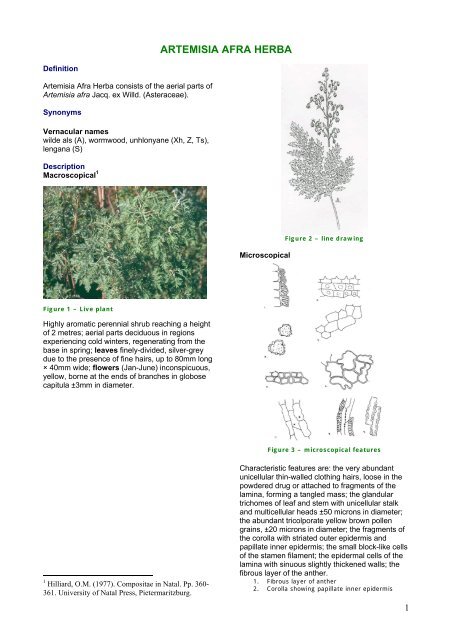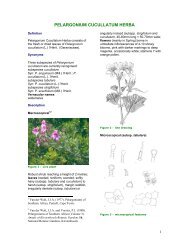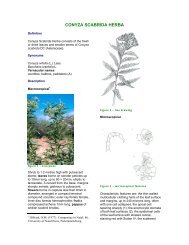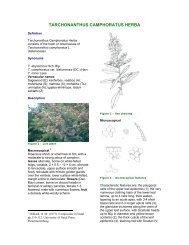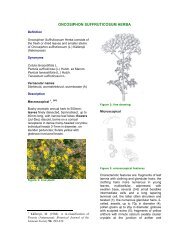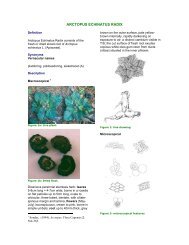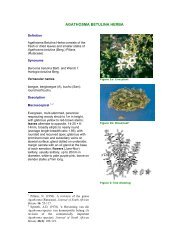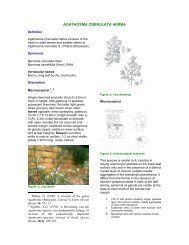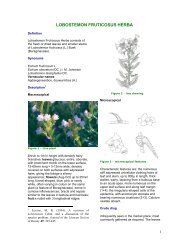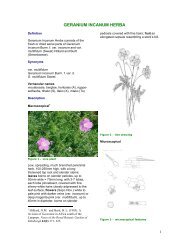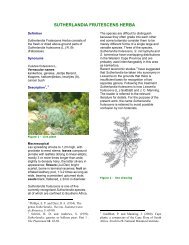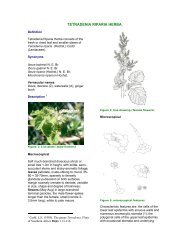ARTEMISIA AFRA HERBA - PlantZAfrica
ARTEMISIA AFRA HERBA - PlantZAfrica
ARTEMISIA AFRA HERBA - PlantZAfrica
Create successful ePaper yourself
Turn your PDF publications into a flip-book with our unique Google optimized e-Paper software.
3. Tricolporate yellow-brown pollen grains, ±20µin diameter4. Polygonal epidermal cells of upper leaf lamina5. Small block-like cells of stamen filament6. Epidermal cells of lower leaf lamina withsinuous slightly thickened walls7. Fragment of corolla (tubular floret) withmicrocrystals of calcium oxalate8. Vessels of stamen filament9. Fragments of corolla with striated outerepidermisR f values of major compounds: 0,25 (grey); 0,31(blue grey); 0,61 (mauve); 0,86 (purple); cineole:0,84 (blue-purple)Crude drugOccurs in bundles of fresh or dried materialcomprising leaves, smaller stems, and flowers inseason. The whole plant is grey in colour andhighly aromatic, the taste extremely bitter.Geographical distributionFigure 6 – HPLC spectrumHPLC on C 18 column, method according toAppendix 2b.Figure 4 – distribution mapWidespread in all provinces of South Africa exceptthe Northern Cape, also Lesotho, Swaziland andnorthwards into tropical Africa; usually in montanehabitats along forest margins and streamsides.Quality standardsIdentity testsMajor compounds:Methanol extract: (Figure 6)Retention times (mins): 10.02; 10.80; 18.53;20.01; 20.32Ethanol (70%) soluble extractive value: notless than 8,0% (range 8,39-30,34%)Volatile oil content: not less than 0,67% (V/W)The volatile oil content of 3 collections analysed inour laboratories ranged from 0,67-2,0%. Previousanalyses found oil yield to vary between 0,3 and0,5% 2 .Purity testsAssayNot yet availableMajor chemical constituentsFigure 5 – TLC plate.Thin layer chromatography on silica gel using assolvent a mixture of toluene:diethyl ether:1.75Macetic acid (1:1:1). Reference compound cineole(0,1% in chloroform). Method according toAppendix 2a.2 See Ref 1. of Major Reference works.2
studies record the presence of yet higherconcentrations of these components in oilsobtained from wild populations of Artemisia afra:1,8-cineole (50.4%), α-thujone (74.91-75.28%), β-thujone (21.49-22.44%), camphor (22.9%) 7 .Dosage formsUsed mainly as an aqueous decoction or infusionapplied externally or taken orally, the extremelybitter taste being masked by the addition of sugaror honey. Fresh leaf may be added to boilingwater and the vapours inhaled.Medicinal usesInternalFor the treatment of cough, croup, whoopingcough, influenza, fever, diabetes, gastro-intestinaldisorders and intestinal worms.Figure 7 – chemical constituentsMicrochemical tests in our laboratories indicatedthe presence of tannins and saponins but not ofalkaloids nor of cardiac, cyanogenic oranthraquinone glycosides. Other studies haveidentified the triterpenes α- and ß-amyrin andfriedelin as well as the alkanes ceryl cerotinateand n-nonacosane in the leaves of South Africancollections of Artemisia afra 3 . Investigation of leafexudate flavonoids revealed the presence of twoluteolin methyl ethers 4 . In an analysis of thesesquiterpene lactones of this species, 10guaianolides and 5 glaucolides were detected inthe overground parts of the plant 5 .Analyses of the essential oils obtained from theleaves of a number of South African populationsof this species have demonstrated considerablevariation in oil composition. The majorcomponents of the oil appear to be α- and β-thujone (27.3-60.1%), 1,8-cineole (1.3-13.7%),camphor (4.6-23.1%) and α-pinene 6 . Other3Silbernagel, E., Spreitzer, H.and Buchbauer, G.(1990). Non-volatile constituents of Artemisia afra.Monatsch Chem. 121(5): 433-436.4 Wollenweber, E., Mann, K., and Valant-Vetschera,K.M. (1989). External flavonoid aglycones inArtemisia and some further Anthemidae (Asteraceae).Fitoterapia 60(5): 460-463.5Jakupovic, J., Klenmeyer, H., Bohlmann,F. andGraven, E. (1988). Glaucolides and guaianolides fromAtremisia afra. Phytochemistry 27: 1129-1134.6 Graven, E., Deans, S., Mavi, S., Gundidza, M.G. andSvoboda, K.P. (1992). Antimicrobial and antioxidativeproperties of the volatile (essential) oil of Artemisiaafra Jacq.. Flavour and Fragrance Journal 7: 121-123.ExternalAs an inhalation for the relief of headache andnasal congestion or a lotion to treat haemorrhoids.In traditional practice, fresh leaf is inserted into thenostrils to relieve nasal congestion or placed inboiling water as a steam bath for menstrual painor after childbirth. Warmed leaves may be appliedexternally as a poultice to relieve inflammationand aqueous infusions administered per rectum orapplied as a lotion to treat haemorrhoids.Pharmacology/bioactivityAntihistaminic and narcotic analgesic effects havebeen reported following preliminary tests (T.G.Fourie, pers. comm. in 8 ). The volatile oil obtainedfrom overground parts of Artemisia afra showedantimicrobial activity against a range of bacteriaand fungi of public health or agriculturalsignificance 6 . The same study demonstratedantioxidant activity of the oil, in preventingdecolouration of β-carotene and linoleic acid.Assays for antimalarial activity of extractsobtained from the dried aerial parts of Tanzanianplants showed weak activity against Plasmodiumfalciparum of petrol ether and dichloromethaneextracts but no activity of methanolic extracts(hypoxanthine uptake assay) 9 . Investigation ofantitumour activity in the mouse, of fresh leafextracts (50% ethanol) of South African7 Graven, E., Webber, L., Venter, M. and Gardiner, J.B.(1990). The development of Artemisia afra Jacq. as anew essential oil crop. Journal of Essential OilResearch2: 215-220.8 Hutchings, A.. (1996). Zulu Medicinal Plants pp. 326-327. University of Natal Press, Pietermaritzburg.9Weenen, H., Nkunya, M.H.H., Bray, D.H.,Mwasumbi, L.B., Kinabo, L.S. and Kilimali, V.A.(1990). Antimalarial activity of Tanzanian medicinalplants. Planta Medica 56(4): 368-370.3
collections of A. afra, showed no activity againstLeuk-L-1210 and Sarcoma-WM256 (IM) lines 10 .No in vitro antimicrobial activity of aqueousextracts of South African collections of A. afraagainst Pseudomonas aeruginosa, Candidaalbicans, Staphylococcus aureus orMycobacterium smegmatis was observed, in theconcentrations used for disc assays in ourlaboratories. A more recent in vitro investigation ofantibacterial activity of aqueous, ethanolic (EtOH)and hexane extracts of dried leaf recordedinhibitory activity of EtOH extracts againstStaphylococcus aureus and Bacillus subtilis, butnot against Escherichia coli or Klebsiellapneumoniae. 11 . Water and hexane extractsshowed no activity in this assay. In the samestudy anti-nematodal activity was demonstrated invitro against Caenorhabditis elegans, by waterand EtOH extracts, at concentrations of 1.0mg/mland 2.0mg/ml. A hexane extract proved inactiveat both concentrations. The same study foundwater and ethanol extracts to be inactive in an invitro assay for anti-amoebic activity (Entamoebahistolytica)The results of an investigation of cytotoxicity andantiviral activity of 16 South African plant species12 showed that aqueous extracts of Artemisia afrawere cytotoxic, at higher concentrations used inthe assay, to HeLa, Vero, Jurkat E6.1, AA-2 andCEM-SS cells. Similar extracts, in a cell cultureantiviral assay, were found not to reduce theinfectivity of either Coxsackie B2 virus or HSV-1.of the α-isomer (LD 50 s.c. in mice: 87.5mg/kg)appears to be greater than that of the β-isomer(LD 50 s.c. in mice: 442.2 mg/kg) 13 . The solubility ofthujone in water is however extremely low 11 and itis doubtful if sufficient quantities of either isomerwould be present in an aqueous extract, as usedin traditional practice in South Africa, to causeconcern. Nevertheless, it would be prudent tolimit the use of this herb to short courses (no morethan two weeks). Both the UK and EC “standardpermitted proportion” of α- and/or β-thujone infood flavourings is 0.0005g/kg 14 .ContraindicationsThujone isomers are reported to be abortifacientand emmenagogic 15 and the use of this herbduring pregnancy is not recommended. Traditionalhealers and herbalists confirm this view.PrecautionsSee adverse reactions above.DosageAn infusion may be made with two tablespoonsful(±7.0g) of dried ground herb to which is addedone litre of boiling water. The mixture is strainedwhen cold. If fresh herb is used, fourtablespoonsful of chopped leaf are infused withone litre of boiling water.Adverse reactionsThe toxicity of thujone, a common component ofthe essential oils of Artemisia, Salvia, Thuja andTanacetum species, is well known. The effects ofexcessive or prolonged ingestion includerestlessness, vomiting, vertigo, tremor,convulsions and fatty degeneration of the liver, asyndrome formerly known as “absinthism”because of its prevalence in Paris café societyabsinthe drinkers of the late 19 th century. Theproduction of absinthe containing thujone wasbanned in France in 1915 and current agriculturalresearch is aimed at selection of low-thujoneraces of Artemisia for oil production. The toxicity10 Charlson, A.J. (1980). Antoneoplastic constituents ofsome Southern African plants. Journal ofEthnopharmacology 2(4): 323-335.11 McGaw, L.J., Jager, A.K. and van Staden, J.V.(2000). Antibacterial, anthelmintic and anti-amoebicactivity of South African medicinal plants. Journal ofEthnopharmacology 72(1/2): 247-263.12 Treurnicht, F. T. (1997). An evaluation of the toxicand potential antiviral effects of some plants used bySouth Africans for medicinal purposes. MSc thesis,University of Stellenbosch.Copyright in this monograph resides with the authors, the SouthAfrican National Biodiversity Institute, the South African MedicalResearch Council and the University of the Western Cape. It maynot be reproduced in whole or in part without the written consent ofthe copyright holders.13 Anon. (1989). The Merck Index (11 th edition): pp.1479-1480. Merck &Co., Inc., Rahway, USA.14 Tisserand, R. and Balacs, T. (1995). Essential oilsafety: a guide for health care professionals. Pp.199-200. Churchill Livingstone, Edinburgh.15 Newall, C.A., Anderson, L.A. and Phillipson, J.D.(1996). Herbal medicines: a guide for health careprofessionals. pp. 231-232. The Pharmaceutical Press,London.4


